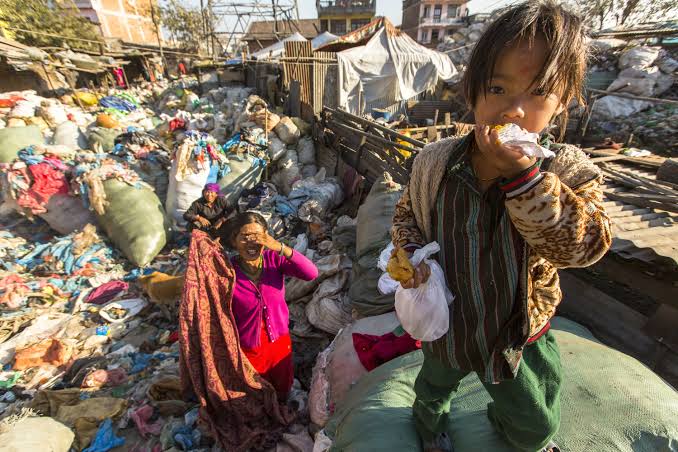•Report by Halimah Olamide
The COVID-19 pandemic has reportedly triggered setbacks in the fight against global extreme poverty.
Reports say this is likely the largest setback since the World War II.
It added that recovery has been highly uneven ever since.
According to a report published by the World Bank, titled “Poverty and Shared Prosperity”, The pandemic increased the global extreme poverty rate to an estimated 9.3 percent in 2020—up from 8.4 percent in 2019.
That indicates that more than 70 million people were pushed into extreme poverty by the end of 2020, increasing the global total to over 700 million.
During the three decades that preceded its arrival, more than 1 billion people escaped extreme poverty in which the incomes of the poorest nations gained ground.
“By 2015, the global extreme-poverty rate had been cut by more than half.” The report said.
The report said that high debt rate has obstructed the recovery of many countries while the rise in food and energy prices fueled in part by the Russia-Ukraine War and climate change has made the progress on poverty reduction more challenging.
Therefore, broadening the world economic progress gap further in eradicating extreme poverty by 2030.
“High indebtedness in many countries has hindered a swift recovery, while rising food and energy prices—fueled in part by the Russian Federation’s invasion of Ukraine and climate shocks among the world’s biggest food producers—have made a return to progress on poverty reduction more challenging than ever.
READ ALSO:
- PDP Holds Rally In Abuja As Atiku Woos Indigenes, Promises Entitlements, Security
- Angry Sanwo-Olu Disbands Landed Properties Special Operations Team
- World Bank Names Ghana, Rwanda, Among 10 Countries Hit Hardest by Food Inflation
“These setbacks have altered the trajectory of poverty reduction in large and lasting ways, sending the world even further off course on the goal of ending extreme poverty by 2030.
“The year 2020 marked a historic turning point—an era of global income convergence gave way to global divergence as the world’s poorest people were hardest hit.”
The report revealed that the incomes of the poorest 40 percent of the world’s population likely fell by 4 percent in 2020.
As a result, the number of people living in extreme poverty likely increased by 11 percent in 2020—from 648 million to 719 million. This increase pushed the extreme poverty rate 1.2 percentage points higher than projections going into the year (extreme poverty had been expected to fall).
This, according to analysis is an “historic setback” in the fight against global poverty.
The current economic shock has led to widespread losses in employment and income as people stopped working and reduced consumption in every region of the world.
The pandemic also increased global inequality. In terms of lost income, the world’s poor paid the highest price for the pandemic, in which the percentage income losses of the poorest were estimated to be double those of the richest.
According to the report, Since 2020, progress in poverty reduction has been slow. Poverty estimates for 2021 and 2022 have been “nowcasted”, that is, gross domestic product (GDP) growth rates have been used to forecast household incomes, assuming all households experience equal growth.
The nowcast estimates suggested that poverty reduction resumed in 2021, but only at the slow rate of progress seen prior to the crisis.
However, projections for 2022 are that the pace of poverty reduction will further stall as global growth prospects dim with the war in Ukraine, a growth slowdown in China, and higher food and energy prices.
High food price inflation can in the short run have especially detrimental impacts on poorer households, which spend a larger share of their income on food.
In the long run, households may adapt to higher prices by changing their con- sumption patterns to at least partly lessen the impacts, and wages in certain sectors can adjust.
The report stated that for many poor rural households engaged in agriculture, higher food prices can be a source of income growth.
The World Bank poverty assessments conducted after the 2008 and 2011 food price crises in Bangladesh, Cambodia, Ethiopia, India, and Uganda showed the important role that higher food prices, which led to higher agricultural income growth and higher agricultural wages, played in raising the incomes of poor households.
However, increases in food prices will hurt some poor such as poor urban households much more than others. The impacts on the urban poor can lead to unrest in cities (as in earlier food price crises) and require a strong policy response.
The report predicted that at least 667 million people are expected to be in extreme poverty by 2022.
That is 70 million more than the forecast would have been without the lingering effects of COVID-19 and the Russian invasion of Ukraine.
In a worst-case scenario, up to 685 million people could be in extreme poverty—89 million more than would have otherwise been the case.
At these levels, the number of people forecasted to move out of poverty in 2022 could be as low as 5 million.


